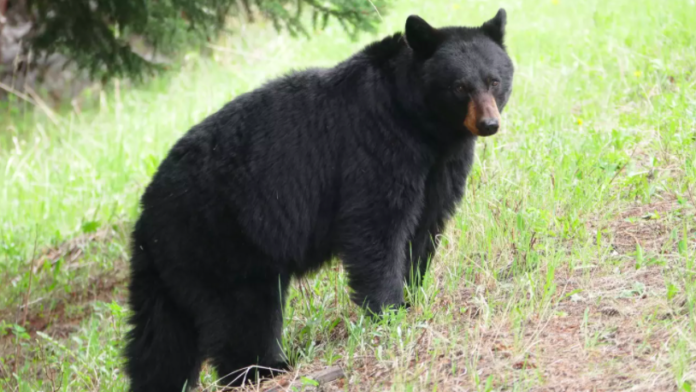NORTHERN RI – From the beaches, to the northwest corner of the state, American Black Bears seem to be increasingly making Rhode Island their home.
Burrillville Animal Control Officer Kerry Courtemanche said she receives reports of bear sightings at least once a week. Glocester is getting calls. And at least one bear has been reported in North Smithfield.
Bears roam from April to November before hibernating during the winter, says Courtemanche.
She said in Burrillville bear sightings are more likely to occur in the northern end of town, such as the Buck Hill area.
The number of sightings in Glocester dwarfs that of Burrillville, said Mary Gannon, wildlife outreach coordinator for the Rhode Island Department of Environmental Management.
She says there have been some 60 sightings in the past several years in that town – about six times the number posted for Burrillville.

Reactions to bears in northern Rhode Island is mixed, judging from social media, with some folks commenting as if the large carnivores are mere cuddly teddy bears, to other commentators expressing grave concern for safety of people and pets, and yet others claiming the land belongs to the bears; with comments stating that they’ve always been here, or leave them alone and the won’t harm you.
How many American Black Bears are officially listed in Rhode Island? Fewer than 10, say wildlife biologists who keep track of the fur-bearing animals in the state, and likely fewer.
But the number of bears in Connecticut now exceeds 800, while the number in Massachusetts could be more than 4,500, say wildlife experts. Sometimes these bears cross into Burrillville, Glocester and elsewhere hunting for food.
“Transients,” Courtemanche explained. DEM expects the number of bears in the western part of the state to increase.
What of black bears in the state’s history? Wildlife experts have stated bears all but disappeared from our area from the 1800s because of hunting and human population growth .
“It is doubtful that black bear has occurred in Rhode Island after 1800,” according to The Mammals of Rhode Island published in 1968 by the Rhode Island Department of Natural Resources, Division of Fish and Wildlife.
But in 1856 Horace A Keach in his book Burrillville; As It Was, and It Is alludes to the presence of bears in the town. He writes of the “prowess,” of “factory boys,” manifesting, “in a terrible slaughter of chipmunks and pigeon woodpecker” — with possibly “the same iron bound smooth bore,” used to shoot black bears.
In some places in America, Black Bear populations have increased; the large predators were reintroduced by wildlife managers, or the increase is attributed to other causes.
One bear reintroduction program was in the 1960s when 254 black bears were brought from Minnesota to Arkansas. By 2002, the population of bears was 2,500, according to some estimates.
But are bears dangerous? Bears are dangerous to humans under certain circumstances, warns Courtemanche. The animal might attack someone who wanders between a mother bear and her cubs, or comes between a bear and a food source.
On the other hand, or rather paw, bears are usually more afraid of humans than humans are afraid of them, she adds.
“Black bears are generally not aggressive and can be scared off with loud noises,” said Gannon. “We are encouraging Rhode Islanders to be ‘bear aware’ and preemptively take action to remove bear attractants. It’s perfectly possible to coexist with bears if humans change our own behaviors.”
However, states known to have larger bear populations have at times experienced problems with human and bear interactions.
Courtemanche says bears love bird-feeders, so take them down from April to November. She says people post photos online of bears feeding at bird-feeders.
She says some residents are concerned about the danger from bears, but says the threat is minimal as long as “common sense” is used.
The ACO noted that last year, a bear was spotted on the bike path across from the bus station in Burrillville.
If you spot a bear, she said, make noise; “Yell, bang pots, use an air horn.”
Courtemanche also says to be respectful and alert, as one wouldn’t want to take a bear by surprise. Bears seem to avoid human beings; however, as Courtemanche warns, easily accessible food such as in a feeder attract them.
This can potentially cause problems for people, a professional paper about bears warns.
“One instance included a bear that was observed feeding at bird-feeders and attempting to gain access to a human dwelling,” noted a Winter 2018 publication Human–Wildlife Interactions. “This learned behavior by the bear raised a red flag… as bears can become bolder and more aggressive when they discover an anthropogenic food source. This can result in property damage and increased risk to human safety.”
What’s more, if black bears, “consume anthropogenic foods,” and nothing bad happens to the bears, they can become human-food conditioned and human-habituated, which can also increase human–bear conflicts.
It’s not clear if “human-food conditioned and human-habituated” was the cause of a bear in Chepachet to damage a dumpster outside the former Purple Cat Winery.
At least one state, Vermont, which has many more bears, has vigorously educated the public about the fur-bearers with a campaign involving, “presentations focused on advice about living with bears, increased website content, press releases, as well as television and radio spots,” and increased the public’s knowledge of bears. Yet the effort didn’t then result in decrease in reports of complaints about bears. Instead, bear-human conflicts were deemed “likely remain high into the foreseeable future.”
The Wildlife Corridors Conservation Act of 2019 and the future for bears and people
More interaction between people and bears might well ensue down the road.
One controversial concept is to repopulate areas called, “wildlife corridors,” through, “rewilding,” which includes restoring wilderness and large predators to regulate the population of other animals, and regulate the eating of plant seedlings by herbivores.
Another facet of “rewilding” is that large carnivores will eat certain mid-sized predators such as raccoons, possums, skunks, and foxes, which in turn prey on other animals such as, for example, birds or their eggs.
Some farmers and other people in rural areas took notice of the The Wildlife Corridors Conservation Act of 2019, then a proposed law before the U.S. Congress, deeming the act problematic — a threat to farmers, and other rural private property owners.
Wild animals don’t know where their designated corridors lie, and their, “unrestricted movement,” would, “undoubtedly see them moving further and further into populated areas,” and they already are, contends Protect The Harvest, a non-profit organization. “Rewilding,” they say, was coined in 1992 by Dave Foreman, controversial activist-author of the book Ecodefense: A Field Guide To Monkeywrenching.
In a 2016 letter titled The Audubon Society of Rhode Island Opposes Invenergy’s Proposed Clear River Energy Power Plant the objection to the plant is in part “because it will disturb the integrity of western Rhode Island’s forested habitats and wildlife corridors.”
In July 2021, The Wildlife Corridors Conservation Act passed the U.S. House of Representatives as part of H.R. 3684, the INVEST in America Act.







